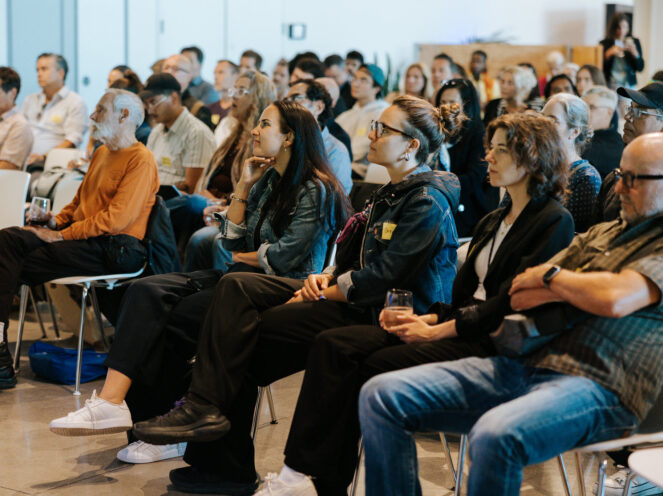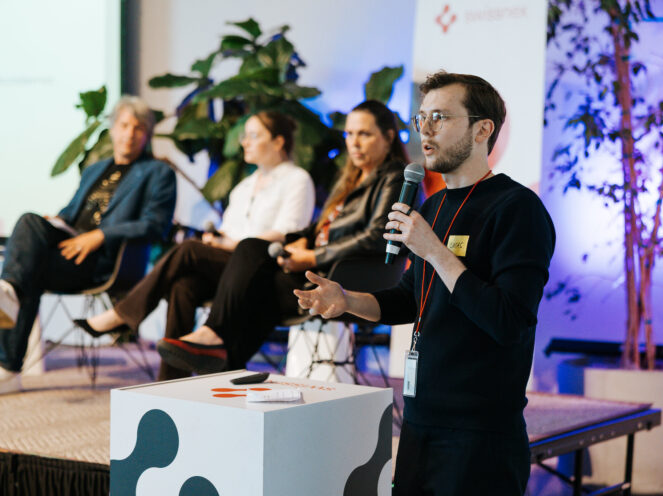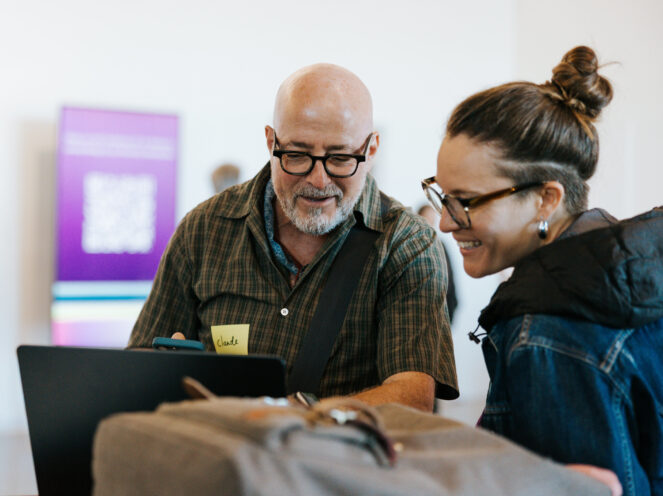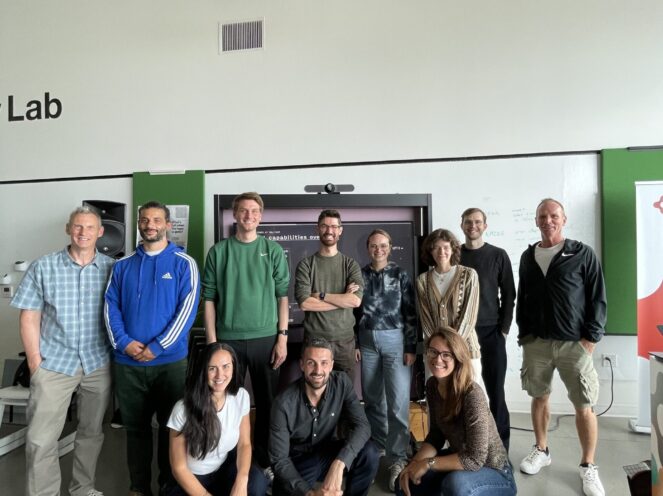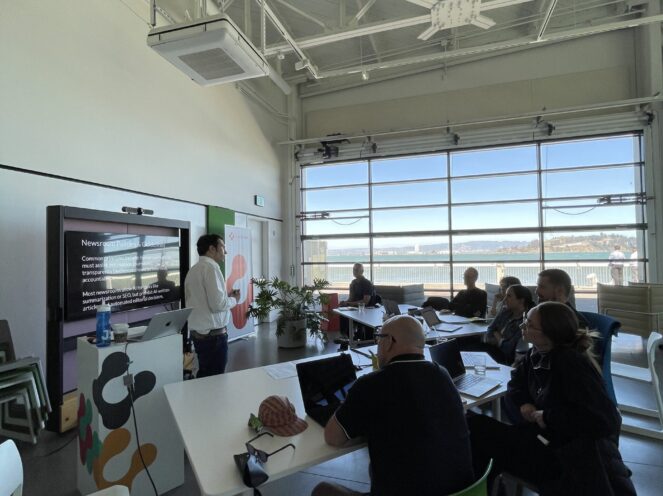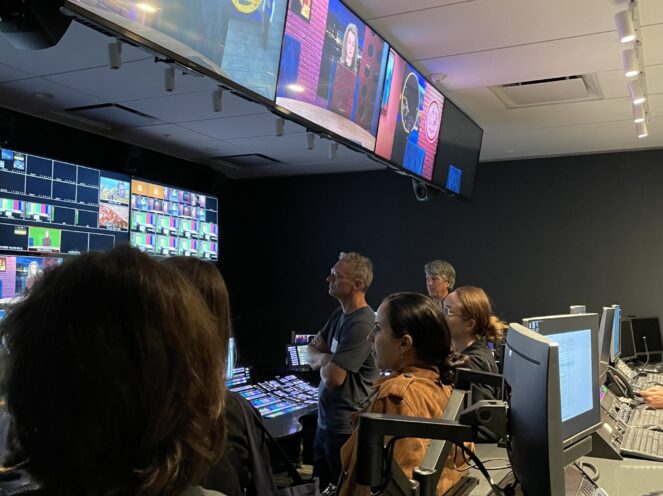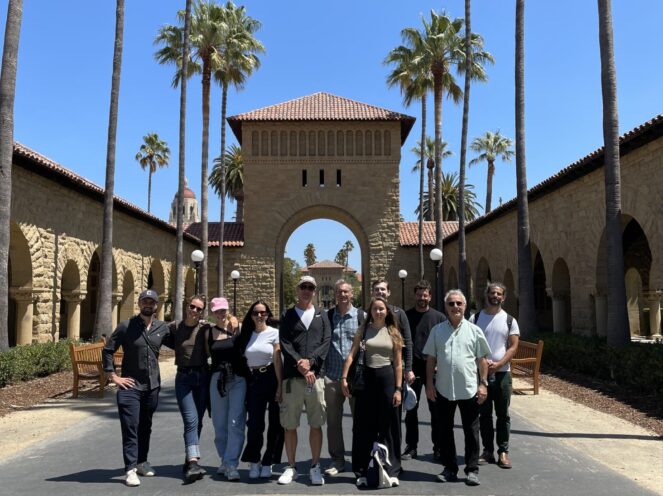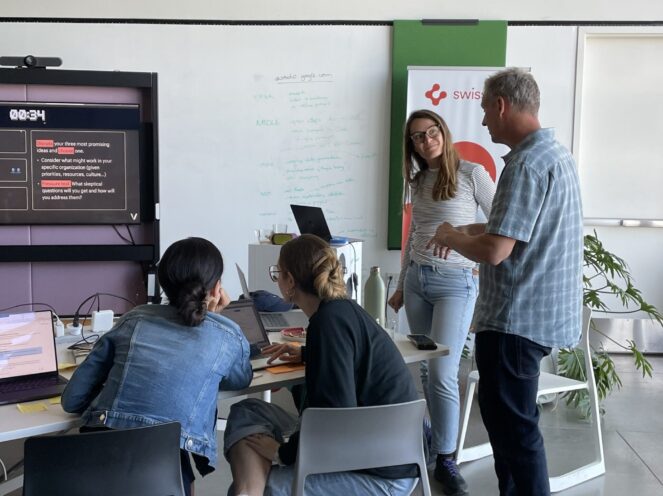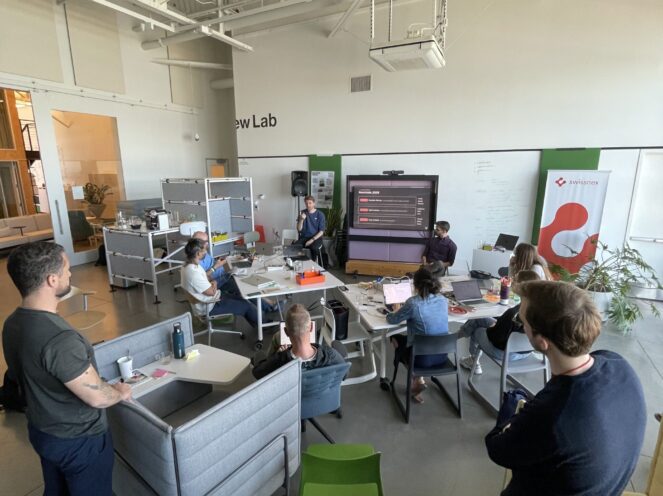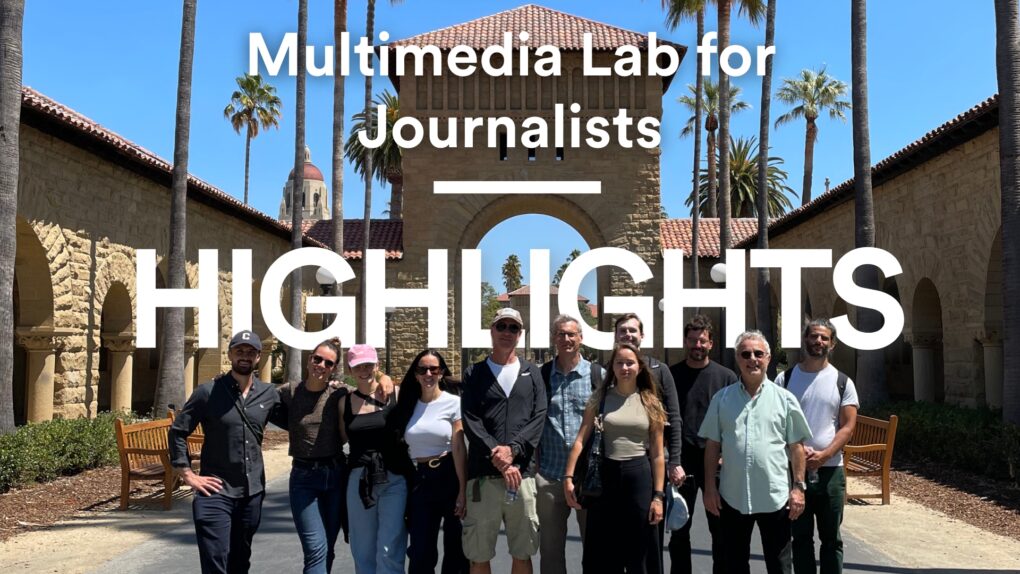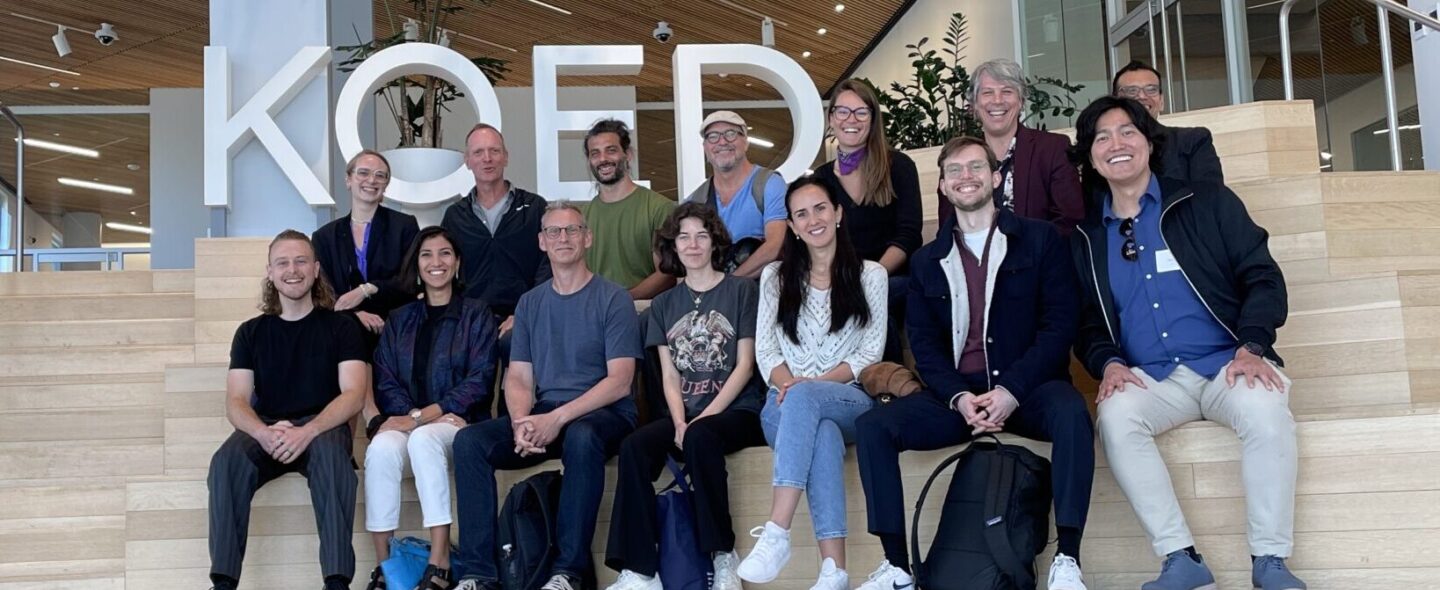
San Francisco – August 26, 2025
From Solid Foundations to Questioning the Profession
In early August, Swissnex in San Francisco hosted nine journalists from Switzerland’s leading media organizations for its third edition of the Multimedia Lab for Journalists. This two-week program promised to reshape the way they think about journalism in the digital age. Each participant arrived with a specific project and vision in mind. From technologies they needed to master, to innovations they hoped to bring back to their newsrooms, these media professionals workshopped with experts, debated the ethics of automated content creation, and questioned the basics of their job as information gatekeepers.
The program opened with a simple yet central question: What does it mean to be a journalist in the age of AI?
First, the fundamentals. The participants started the program speaking about the future of AI and journalism with Djordje Padejski (Stanford’s John S. Knight Fellowship). He offered a perspective that gave the journalists a new understanding of their profession and the need to stay resilient and adaptable to change. As he put it: “AI will not replace journalists, but a journalist who learns to leverage AI will replace the one who doesn’t”.
Speaking of knowledge transfer, the participants benefited from Kaveh Waddell and Patrick Swanson’s (Verso) guidance throughout the program. The two experts framed our cohorts’ projects and brought fresh ideas that helped break through their doubts and technical roadblocks. Rather than theoretical discussions, participants worked hands-on with AI tools. For example, learning to process hours of interviews in minutes, and using data analysis instruments that identify patterns across thousands of documents. But, as much as learning to master instruments is important, sharing thoughts and experiences with peers is even more crucial to make great ideas emerge.
The first confrontation with the Bay Area’s rapidly shifting mindsets and business models came during the site visit at KQED. Conversations with Tim Olson, Eric Dhan, and Ernesto Aguilar revealed a media organization grappling with the same challenges facing newsrooms worldwide: shrinking budgets, changing audience expectations, and the flood of AI-generated content competing for attention.
“We found that offering authenticity, human connection, and live journalism experiences helps our voice stand out from the noise generated by AI content,” explained Tim Olson. This shows how local newsrooms can compete not by matching AI’s speed but by emphasizing uniquely human qualities.
To wrap up the first week on a high note, sessions with Andy Lee Roth from Project Censored and Fred Grinstein from Machine Cinema challenged participants’ technological knowledge, our cohort critically examined the concept of AI making automated decisions, how algorithms are shifting power dynamics in society, and learned to audit algorithms to understand what goes on inside these black boxes. The participants learned to use the latest generative technologies for video, images, text-to-speech, and vice versa, using prompts and workflows. In just a few moments of practice, participants were able to create stunning avatars and digitize their ideas.
Looking back at the first public event of the program, “From Prototype to Publication – AI Initiatives for Newsrooms,” participants have had the opportunity to attend a conversation on real AI implementation in the newsroom. Led by Julia Smith (Hearst Newspapers), Katherine Ann Rowlands (Bay City News), and Tim Olson (KQED), the discussion cut through all the noise and made sometimes abstract, futuristic concepts concrete and tangible. From data aggregators and sharing platforms to election tools, the opportunities to make important journalistic works more accessible to the public are vast.
On the emergence of new AI instruments that are increasingly powerful and relevant for journalistic investigation, Katherine Ann Rowlands said: “Media should aim for transparency. Making clear not just if AI is involved in processing information, but most importantly, how it is applied”. The panel revealed how technology is moving from experimental to essential across the industry, and how it can affect public trust.
For our cohort of Swiss journalists, the discussion connected their learnings to trends happening in U.S. newsrooms. The Q&A that followed showed the audience’s mix of excitement and concerns about integrating AI into daily workflows.
The Transformation
The second week got off to a flying start. The participants headed to Stanford University to meet with Cheryl Phillips (Big Local News), Ryan Pitts (Big Local News), and Djordje Padejski (Stanford’s John S. Knight Fellowship) at the JSK Journalism Fellowships. The discussion focused on tools for media professionals, data-sharing platforms, and multiple data journalism initiatives. AI can help journalists create instruments for both readers and media professionals and process huge amounts of data. From live interactive maps for elections, environmental hazards, or pandemics to automated workflows scraping states’ websites, official news, and delivering info directly to newsrooms, the opportunities to strengthen journalism are wide. By collaborating with other newsrooms, sharing data, and creating custom tools, journalists can empower each other and provide more transparent information. This creates multiple possibilities to investigate topics and subjects that were previously inaccessible from a data processing and exposure perspective.
The second newsroom’s site visit at the San Francisco Chronicle confirmed the need for professional collaboration and resource sharing. In an era of rapid technological change, the ability to adapt quickly matters a lot. Indeed, a lot of traffic has shifted away from newspapers’ websites and search engines toward AI searching tools. Considering this attention migration, Emilio Garcia-Ruiz (San Francisco Chronicle) shared that it will be difficult for media professionals to address these challenges in the post-search era and suggested that sharing resources between newsrooms and licensing intellectual property could be viable long-term strategies. Connections to the local audience are another piece we can add to our puzzle. Journalists may be evolving from gatekeepers to bridge-builders, cultivating trusted connections between information and communities.
To go deeper, sharpening and enhancing journalists’ understanding and critical analysis of methods and instruments built for the journalists of tomorrow, the session with Enrique Lopez (Freepik) showed the participants how to integrate visual workflows and generate compelling audiovisual content in seconds. Not only the quality but also the power of mastering such technology left the cohort reflecting on the possibilities and limitations that these tools create. Girish Gupta showed how he investigates with pattern recognition and document scraping as a journalist and researcher, while David Cohn (Advance Local) emphasized the enduring value of quality information and the fundamentals of strong media products.”
The Journalism Mixer, a private event organized by Swissnex in San Francisco, gathered the Swiss participants and local media professionals for an evening of cross-cultural discussion and industry insights. On stage, Cathy Dogon (Le Temps), Alexandra Ulmer (Thomson Reuters), Elodie Mailliet Storm (CatchLight), and Grant Marek (SFGATE) shared their perspectives and experiences. Speaking about trust and relationship with the public, Grant Marek was clear: “Newsrooms and journalists should avoid using AI throughout the creation and reviewing process of information, a key moment in which the quality can quickly degrade.” Away from the workshop setting, the attendees joined focus groups to discuss polarization, visual trust, and the challenges of rebuilding social contracts with readers.
The Aftermath
After two weeks, the participants returned to their newsrooms equipped not only with proper technique but also with greater responsibilities regarding the rapid changes happening in their profession and a roadmap for careful integration and impact. They witnessed the journalism and Information and Communication Technologies’ revolution right at the heart of it.
Cathy Dogon (Le Temps) reflected: “I thought AI would be a disaster for journalism. Now, I am more optimistic because small newsrooms have more power to investigate deeper and focus on value-adding tasks.” With tools and mentor support, Cathy was able to analyze large documents and nearly complete a tough investigative project she’d been stuck on for several months.
Lucas Hagin, Creative Industries Program Manager at Swissnex in San Francisco, observed a shift: “Beyond the hype and the idea of AI as a black box, participants moved from urgency to agency. The cohort advanced from theory to practice, running confident experiments focused on trust, guided by ethics, and committed to serving their communities. Participants left with practical workflows, clear frameworks, next steps, and a renewed responsibility to deliver quality information.”
For Nicole Krättli (NZZ), the program marked a turning point in her view of digital innovation: “I changed the way I interact and think about AI. I feel that if journalists don’t learn how to use the latest technology, they will be left behind.”
As Claude Ansermoz (former 24 Heures) echoed this sense of transformation, “I used to think my project was impossible, now I am starting to believe in it.”
This edition revealed a clear pattern: the most effective implementations consist of combining new technology with solid journalistic fundamentals. Innovation is about amplifying traditional skills, not replacing them.
The 2025 Multimedia Lab cohort consisted of Tom Vaillant (20Minuten), Didier Bonvin (RTS), Enora Maurer (SRF), Fabienne Jacomet (Schaffhauser Nachrichten), Claude Ansermoz (former 24 Heures), Simone Pengue (Freelance), Cathy Dogon (Le Temps), Matthew Allen (swissinfo.ch), and Nicole Krättli (NZZ).
Written by Guillaume Egger, Communications Associate at Swissnex in San Francisco. Guillaume is committed to communicating about Swissnex in San Francisco activities, promoting Swiss innovation, and bringing the freshest news.
Impressions
-
![]()
-
![]()
-
![]()
-
![]()
-
![]()
-
![]()
-
![]()
-
![]()
-
![]()
-
![In early August, Swissnex in San Francisco hosted nine journalists from Switzerland's leading media organizations for its third edition of the Multimedia Lab for Journalists. This two-week program promised to reshape the way they think about journalism in the digital age.]()
Multimedia Lab for Journalists 2025
In early August 2025, Swissnex in San Francisco welcomed nine journalists from Switzerland’s top media outlets for the third edition of its Multimedia Lab for Journalists. Over the course of two weeks, the program set out to transform their perspectives on journalism in the digital era.
